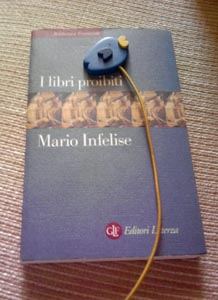Today we are inaugurating the new space of Finestre Sull’Arte dedicated to books: we will briefly talk to you about some books that we have read, that we think are interesting to share with you and that, of course, we recommend! Today we start by examining a broad historical period, the one we mainly cover in our podcast, namely the period from about 1450 until the late eighteenth century. And we do so with a volume by Mario Infelise, I libri proibiti - da Gutenberg all’Encyclopédie, published by Laterza.
The text in question intends to talk about book censorship in Europe in the aforementioned period and taking as its starting point theinvention of movable type printing by Johann Gutenberg (an invention that posed several problems for censorship activity) and as its endpoint 1789, the year in which the Declaration of the Rights of Man and of the Citizen sanctioned freedom of the press and of thought.
 |
| The banned books of Mario Infelise |
We thus discover the figures of characters perhaps little known to most but who played no small part in the events that affected them: this is the case, for example, of Guillaume Lamoignon de Malesherbes, who in the mid-18th century, in the Age of Enlightenment, had the merit of pointing out all the contradictions of the French censorship system, or Ludovico Beccadelli, archbishop of Ragusa (the Dubrovnik today in Croatia), who expressed his perplexities about the prohibition of the reading of the Bible in vernacular languages.
It is a journey that also acquaints us with people who paid with their lives for their desire for freedom, such as the Friulian miller Domenico Scandella, nicknamed Menocchio, who was tried and executed by theInquisition, or such as the more illustrious man of letters Ferrante Pallavicino, who was captured by deception in Avignon and then tried and executed. Adding to the narration of the stories of these characters is the description of the methods of censorship, which in certain eras were based not only on banning the reading of certain books (the Pauline Index of 1559 banned the entire works of authors such as Erasmus of Rotterdam,Niccolò Machiavelli and François Rabelais), but also on correcting those that were not intended to be banned but contained passages that in the eyes of the censors could not be read by the public.
This is the case, for example, with Francesco Petrarch, who underwent an almost complete rewriting of his Canzoniere (it is estimated that only 17 percent of the sonnets and 26 percent of the songs remained the same as the original) by Friar Girolamo Malipiero: this fate, which in some cases reached more than grotesque outcomes (hints of Luther made an appearance in Petrarch’s work itself), also befell other authors such as Giovanni Boccaccio or Baldassarre Castiglione, and it was certainly a more insidious practice than prohibition in that many authors’ thoughts were completely distorted and distorted. Mention should also be made of the aforementioned case of the prohibition of the reading of vernacular Bibles in Italy, a measure that came definitively into effect with the Clementine Index of 1596 (and abolished only in 1758 under Benedict XIV: a measure that, according to historian Gigliola Fragnito, would have had “incalculable consequences on religiosity, culture and mentality”). But it is not only the Church that is the object of investigation in the research, for we discover that states also adopted different systems of censorship. Vast spaces are also given to describing the application of censorship, with all that ensued.
Reading I libri proibiti (Forbidden Books ) by Mario Infelise helps us to enter into the merits of some of the events that profoundly characterized the culture of a long historical period and that sometimes made their echoes felt even in the arts (events that had serious consequences on a cultural, social and even economic level), and also makes us understand in what climate men of culture or, in general, anyone who wished to be able to read and express their thoughts freely. This is a reading that we also recommend because it makes one want to delve deeper and above all because, if until before we were not familiar with the events of censorship in these centuries, after reading The Forbidden Books we will look at our history with a somewhat different (and certainly more in-depth) eye.
Forbidden Books - from Gutenberg to the Encyclopédie
by Mario Infelise
Laterza, 2008 (first edition 1999)
153 pages
12 euro
Warning: the translation into English of the original Italian article was created using automatic tools. We undertake to review all articles, but we do not guarantee the total absence of inaccuracies in the translation due to the program. You can find the original by clicking on the ITA button. If you find any mistake,please contact us.